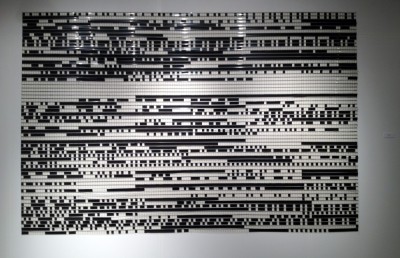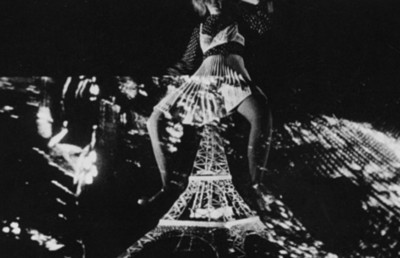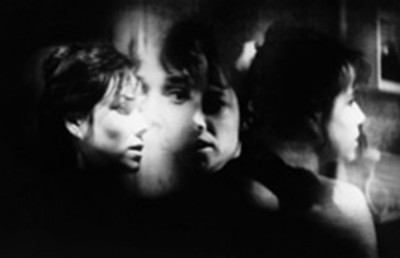Austrian Avant-Garde Cinema Explored, Part 1
Kurt Kren and Valie Export
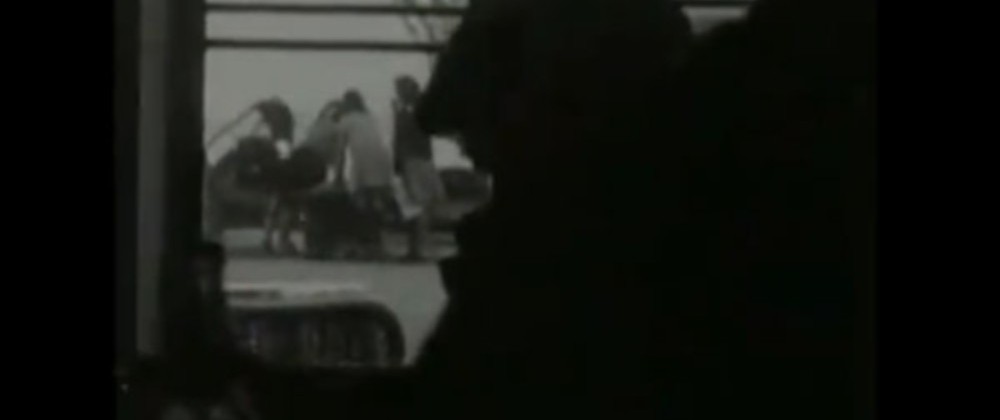
Index is a specialty DVD label created with the specific aim of promoting Austrian experimental film and video artists. It is a joint project of Medienwerkstatt Wien and sixpackfilm. They have begun their project with a launch of 15 DVDs of mostly Austrian artists, with the intent of widening their horizon to include non-Austrian filmmakers in the near future. For a complete list of the 15 artist DVDs and the films included you can visit their website. In this two-part essay I will discuss the DVDs that I had the good fortune of viewing recently, those featuring Kurt Kren, Valie Export (in part one), Mara Mattuschka, Gustav Deutsch, and Manfred Neuwirth (in part two).
Austrian experimental cinema may appear esoteric to even the informed film person, although Peter Kubelka is the one name which should be familiar to the experimental film cognoscente. Arguably of equal importance where the formation of experimental cinema is concerned is Kurt Kren, born in Vienna in 1929 (deceased 1998) and the elder statesman of the 15 artists featured in the Index catalogue. Along with Kubelka, Kren is one of founding fathers of what P. A. Sitney would later coin in his seminal book Visionary Cinema, the structural film. The structural film was a varied beast which spun out of one central thrust: a channelling of the primary, mediumistic qualities of cinema, such as light, movement, time, space –the materiality of film– into whatever representational ‘object’ the film stock happened to record –a person, a chair, a moth, a wall, the film apparatus, etc. – or in some cases, had been physically encoded, reprinted, or scratched onto the film stock. The optical and perceptual properties of film, and by extension how the human eye and brain interprets and reads these properties, became important areas of exploration for the structural filmmaker. We become aware of the materiality of film in a conventional narrative film only, for example, when a piece of hair in the gate becomes annoyingly visible on the screen, or when watching an old print with accumulated scratches and dirt. Such ‘qualities’ which are a hindrance to the mainstream film become the working material in the structural film. To paraphrase Marshall McLuhan, in the structural film “form is the content.” For this reason the structural film can be seen as the last great gasp of the modernist project of an art form’s self-examination.
One of the first to begin to chart these explorations was the Austrian filmmaker Kurt Kren, who made his first film in 1957. Kren is the only filmmaker with two DVDs in the Index catalogue, 001 “Action Films” and 002 “Structural Films.” The latter is the DVD under discussion here, which includes 16 short films totalling approximately 70 minutes. One could never use the term “approximate” with regards Kren, who, in the majority of his structural films, little left to chance. This is a result of the “systemic structure” he employs as a modus operandi for many of his films, especially his early ones, whereby the film was made according to a prearranged mathematical formula that can be set in the pre or post filmmaking stage (single frame shooting processes; using multiple masks over the lens and re-exposing the same piece of film; serial montage where each subsequent shot’s frame length is the total of the two previous shots -for example, 1, 2, 3, 5, 8, 13, 21, 34, etc.). This “systemic structure” is Kren’s most important influence on the legacy of structural filmmakers.
In keeping with his sense of precision all of Kren’s film titles include the sequence the film represents in his chronology and the year it was made. Hence his first film, made in 1957, is titled 1/57 Versuch mit synthetischem Ton_(_Experiment with Synthetic Sound Test, 16mm, 1:23). Viewing the 16 films consecutively reveals certain connections and formal and thematic patterns. For example, the theme of voyeurism is a concern across several films: _49/95 tausendjahrekino_(_Thousandyearsofcinema, (16mm, 2:40), 5/62 Fenstergucker, Abfall etc._(_People Looking at of the Window, Trash. Etc.,(16mm, 4:48), 15/67 TV, (16mm, 4:08), and 32/76 An W + B_(_To W + B, 16mm, 7:42); as is an interest in the physiognomy of the human face, which informs _2/60 48 Köpfe aus dem Szondi-Test_(_48 Heads From the Szondi Test, 16mm, 4:19), 36/78 Rischart, (16mm, 3:02), and _28/73 Zeitaufnahme(n)_(_Time Exposures, 16mm, 2:40). Formally there is a marked contrast from one film to another between a rapid-fire paced montage and a more contemplative, slowed down rhythm; while there is an overriding formal effect which I call ‘fixed movement,’ where static images appear to move or give the impression of mobility due to shifting focal lengths, rapid alternation between positive and negative imagery, flicker effects, etc.
The DVD begins appropriately with Kren’s first film, 1/57 Experiment with Synthetic Sound Test, a short (1:23) minor effort which alternates between readable and abstract representations of three basic subjects: a wall, a hand gun on the lower bottom of the frame, and close-ups of a cactus. Kren’s first important work where structuralism is concerned is his second film, 2/60 48 Heads from the Szondi-Test, his first to feature ‘serial montage’. As his subject, Kren used 48 faces that made up a psychological test called the Szondi Test. The 48 faces were shot using a single-frame process, clicking the shutter to advance at one frame per time, at a rate of 8 frames (1/3 of a second) per face. The result of this rapid fire ‘batch frame’ editing is a hypnotic mood which eventually gives way to a sinister tone, as the progressive montage gives one the impression of viewing a catalogue of criminal mug shots. This film is also the first to feature what I have called the “fixed movement” effect, where static photographs are made to appear animated, in this case because of the slight difference in the positioning of an eye or mouth from one face to the next.
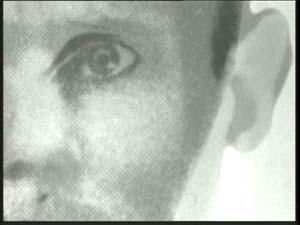
In his book Abstract Film and Beyond Malcolm Le Grice refers to 3/60 Baume im Herbst_(_Trees in Autumn, 16mm, 5:03) as the first structural film (some would cast their vote for Kubelka’s 1958 Schwechater or Marc Adrian 1957 Random). Trees in Autumn uses a similar strategy as the previous film –the single-frame process, ranging from 1 to 8 frames per ‘shot’– and is edited in camera. The rustling of the scratched-on-film sound renders an organic feel which, given the natural subject matter, makes it sound like wind or thunder. In Kren’s fourth film, the aptly titled 4/61 Mauern pos.- neg. und Weg._(_Walls Positive Negative and Way, 16mm, 6:09), positive and negative close-up shots of a crumbling wall and long shots of a meadow alternate to create a flickering sense of movement purely through fluctuations in light. Gabriele Jutz in the DVD liner notes adds that some critics had compared Kren’s third film, Trees in Autumn, to the work of Jackson Pollock. I find this point even more striking in Walls Positive Negative and Way.
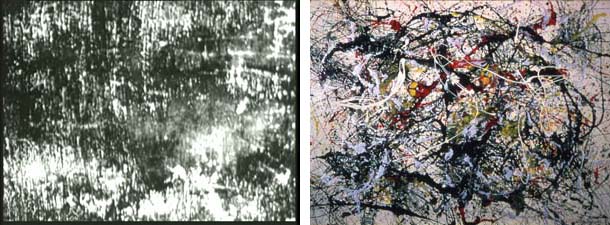
Kren presents the “systemic structure” with a more recognizable subject in 5/62 People Looking out of the Window, Trash. Etc., which is surely one of the first concentrated examinations of voyeurism, with rapid fire shots of people looking out of their window juxtaposed with subjective point of view shots and images of urban debris and decay.
15/67 TV is a simple yet fascinating exercise in “eye-guidance.” Seeing how Kren’s titles are often so descriptive of what the film is about, I’m surprised 15/67 TV was not called “4 Planes of Action.” Where does the eye look to, and in what sequence, when perusing an image? Kren insinuates this with an examination of cinema’s three-dimensionality by staging a shot with action occurring across four planes of action. The central recurring image is a hand-held shot taken from the inside of a harbor cafe overlooking a port area. However, Kren fragments this space across time. As Kren explains in the liner notes, five takes representing a slight temporal variation on the situation was printed 21 times and laid out to emulate “a children’s rhyme.” The slight temporal variance results in changes across the four planes of actions that are registered intermittently throughout the film’s length as jump cuts, which are smoothed over by the continuous intercutting of black leader. The depth of field shot presents a view with the following four planes of action. Plane 1 is the foreground, where a few people in dark silhouette are seated on the right. Plane 2 is the mid-ground just beyond the cafe window, where we sometimes see a man walking with his child from screen left to right. Plane 3 is in the background, where we see three (sometimes less) girls standing. And plane 4 is the extreme background, where we sometimes see a crane on a ship moving into the frame. Planes 1 and 3 are fairly constant, while planes 2 and 4 provide evidence of the temporal variation. This film is ‘Bazinian’ in the true sense because we must decide where to look, and at what, to discover the pattern.

One of the most politically resonant films on the Kren DVD is 20/68 Shatzi, (16mm, 2:29). The film begins with grey and white blotches, interspersed with black frames. An indecipherable image slowly gives way to one central image: a photograph of a concentration camp officer standing on the right overlooking a corpse-littered ground. The image becomes once again grainy and less clear as Kren moves the camera progressively closer to the photograph, as if to suggest the way collective memory can fade. Only now that we know what the image is, it lingers in our mind. Haunting.
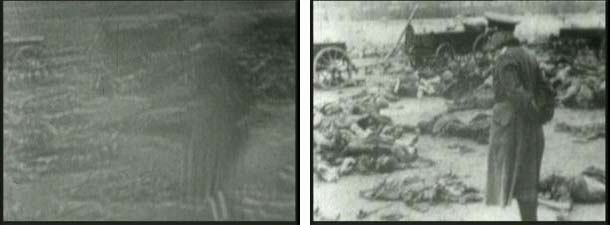
Second to Kren in terms of International recognition, is Valie Export (born in 1940), who was one of the first female avant-garde artists to explore feminist issues of sexuality and body politics, beginning with the 1968 film Tapp und Tast Film_(_Tap and Touch Cinema) (not included on the DVD). Export was also instrumental in defining and promoting the term “Expanded Cinema,” a movement in Europe in the 1960s that tried to rethink cinema and shift it closer to a multi-artistic enterprise. Expanded Cinema became an attempt to break through conventional venues of film presentation –moving cinema beyond the comfy single theatre– and beyond conventional spectator passivity of linear narrative cinema. To quote Valie Export, “‘Expanded cinema’, i.e. the expansion of the commonplace form of film on the open stage or within a space, through which the commercial-conventional sequence of filmmaking –shooting, editing (montage), and projection – is broken up…” [1]. Expanded Cinema includes multi-media films, installation piece films, films screened in museums, ‘action films’ where “Happenings” are recorded, and would certainly include today’s digital/computer cinema. However, the three films offered on the regrettably short (36 minutes) Export DVD, Mann & Frau & Animal, 1970-1973, 16mm, 9 min.), …remote…remote…, 1973, 16mm, 10 min.), and Syntagma, 1984, 16mm, 17 min.), are a representation of her feminist body politics.
Indeed, Mann & Frau & Animal and …remote…remote… are anything but easy films to watch. Mann & Frau & Animal begins disarmingly enough with random hand-held black and white shots of a bathtub. A woman enters the tub. Some of the shots, such as the overhead angle close-up of the drain, echo the iconic imagery of Hitchcock’s Psycho, and perhaps the mindset of the bathroom as a site of sexualized cinematic violence. However, this is soon flipped on its head when the scene cuts to the woman lying in the tub with her legs spread, masturbating with the water flow of shower head. The camera zooms in to a close-up of the clitoris, as moans of pleasure are heard. Whatever little sense of the erotic or pornographic these images provide is soon obliterated when the scene shifts to color and the previous orgasmic moans give way to animal like grunts, which are comically emanating from the vagina. In successive shots we are ‘treated’ to de-eroticized shots of the vagina, first excessively lubricated in a greyish smear and then oozing blood.
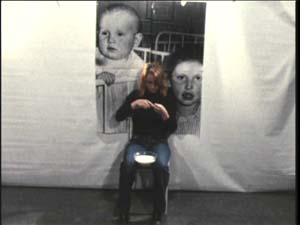
…remote…remote…. is one of the most emotionally wrenching ten minutes in cinema I have experienced in a long while. The short film begins with a glum, yet attractive young woman sitting in front of a white sheet, on which hangs a huge photo of two children –her own we would surmise if this was a narrative. She sits with a bowl of milk on her lap and an exacto knife in her hand. Our first thought, naturally, is suicide. The scene cuts to a close-up of her hands as she shaves her finger nails and begins to pick at her cuticles. The suspense grows thicker with every passing second, exaggerated by a constant, monotonous ticking sound. The self-mutilation begins to reveal physical evidence. She places her hand in the bowl of milk, then takes the hand out and continues to poke and jab at her cuticles with reckless indifference. The scene reaches its visceral climax with a cut to an extreme close-up of her bloodied finger, with the razor continuing to pick at the finger tip in unflinching close-up (I’m feeling queasy just describing it).
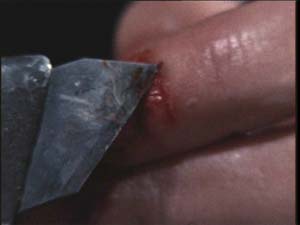
Temporary relief is provided when the scene cuts back to a close-up of the finger as it is dipped slowly into the milk bowl, only now we see blood mix with the milk. The scene cuts to a long shot and then thirty seconds from end the woman mysteriously disappears into thin air. The camera slowly zooms into the photo of the two children. Now we can make out the details of the photo: the little girl on the right is embracing the hand of a younger baby in a crib on the left. Again, we can only interpret this young girl to be the woman (there is a strong physical similarity). We learn nothing of who this woman is, which only makes us wonder what could have led this woman to such self-mutilation.
For the third and most recent film on the DVD, Syntagma, Export gives the viewer an emotional reprieve by employing a more stylized aesthetic approach to the same issue of body politics. Both the film’s style and content is set-up early on with a voice-over quote from the psychiatrist R.D. Laing’s The Divided Self, a popular, existential account of madness and schizophrenia in the modern world. The book, written in 1959, interprets mental illness as a form of modern alienation which occurs both within and without a person. Robert M. Young describes the book’s core as follows, “The self becomes dissociated both from its own body and from the whole external world of people and events. It is thereby precluded from having a direct relationship with real things and real people; it relates instead to objects of its own imagination and memory. Its own bodily experiences and actions become alien — part of a false-self system.” [2] Laing’s central ideas form the stylistic core of Syntagma, as Export employs a vast panoply of inventive variations on visual schizophrenia or alienation, including split screens, refracted and reflected imagery, mirror effects, and one beautiful Cocteauesque image of a woman lying face down on an outside staircase ballast.
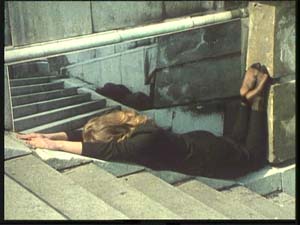
Some of the film’s use of the fragmented female body may recall the aesthetics of the 1960’s female-driven art cinema, most notable Jean-Luc Godard’s A Married Woman, (1964), Ingmar Bergman’s Persona (1966) and the Michelangelo Antonioni tetralogy. But the short film experimental form grants Export the luxury of being fully focused on the theme of the “divided self.” The three films on this DVD form a powerful testament to Export’s varied investment in feminized body politics. One of the many imagistic lines heard in _Syntagma_’s voice-over wonderfully encapsulates this investment as, “…shrapnels of female imagination.”
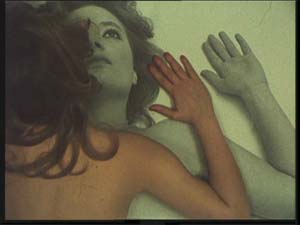
To purchase any of these DVDs please visit the Index website.
Endnotes
1 Valie Export. “Expanded Cinema as Expanded Reality.” Senses of Cinema. Issue 28 (Sept.-Oct., 2003). Internet; accessed Dec. 15, 2005.
2 Robert M. Young. “The Divided Science.” Internet; accessed Dec. 21, 2005. Reprinted from Delta No. 38, Spring 1966, pp. 13-18.




